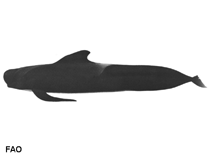Globicephala melas (Traill, 1809)
Long-finned pilot whale| Native range | All suitable habitat | Point map | Year 2050 |

|
| This map was computer-generated and has not yet been reviewed. |
| Globicephala melas AquaMaps Data sources: GBIF OBIS |
Classification / Names Common names | Synonyms | CoL | ITIS | WoRMS
Mammalia | Cetartiodactyla | Delphinidae
Environment: milieu / climate zone / depth range / distribution range Ecology
Pelagic; depth range 30 - 1800 m (Ref. 122880). Polar; 90°N - 90°S, 180°W - 180°E
Distribution Countries | FAO areas | Ecosystems | Occurrences | Introductions
Northeast Atlantic, Atlantic Ocean, Indo-Pacific, Mediterranean, and the Antarctic: Central Pacific sector at 68°S, 120°W; Globicephala melas melas: Ungava Bay, Greenland, Iceland, Faroes, Norway, North Carolina, Azores, Madeira, Mauritania, Western Mediterranean, Newfoundland; Globicephala melas subsp.: Japan, Sea of Japan; Globicephala melas edwardii: Brazil, South Africa, Crozet, Heard Island, Australia, New Zealand, Chile, Scott Island, Antarctic Convergence (Ref. 1522). Polar, subtropical.
Length at first maturity / Size / Weight / Age
Maturity: Lm ? range ? - ? cm Max length : 670 cm TL male/unsexed; (Ref. 1394); 570 cm TL (female); max. published weight: 2.0 t (Ref. 1394)
Life cycle and mating behavior Maturity | Reproduction | Spawning | Eggs | Fecundity | Larvae
Main reference
References | Coordinator | Collaborators
Jefferson, T.A., S. Leatherwood and M.A. Webber 1993 FAO species Identification Guide: Marine Mammals of the World. Rome, FAO. 320 p. + 587 figures. (Ref. 1394)
IUCN Red List Status
(Ref. 130435: Version 2025-1)
CITES status (Ref. 108899)
CMS (Ref. 116361)
Threat to humans
Human uses
Fisheries: commercial
FAO - Fisheries: landings, species profile | FishSource | Sea Around Us
Tools
More information
Max. ages / sizes
Length-weight rel.
Length-length rel.
Length-frequencies
Mass conversion
Abundance
Internet sources
BHL | BOLD Systems | CISTI | DiscoverLife | FAO(Fisheries: species profile; publication : search) | Fishipedia | GenBank (genome, nucleotide) | GloBI | Gomexsi | Google Books | Google Scholar | Google | PubMed | Tree of Life | Wikipedia (Go, Search) | Zoological Record



